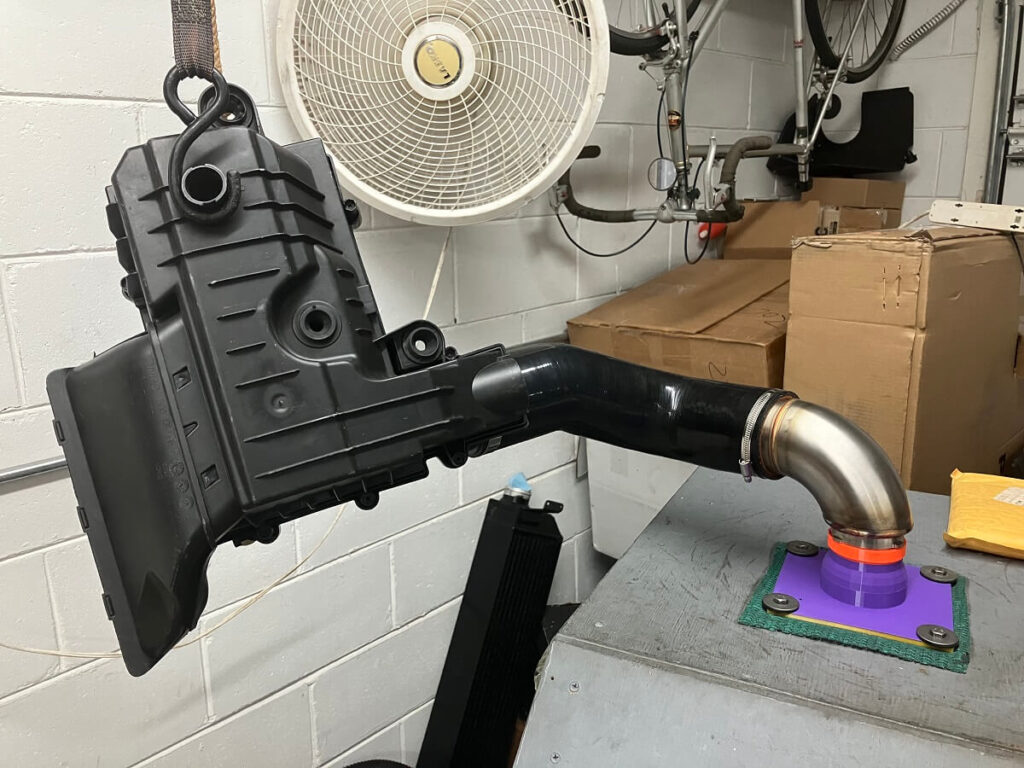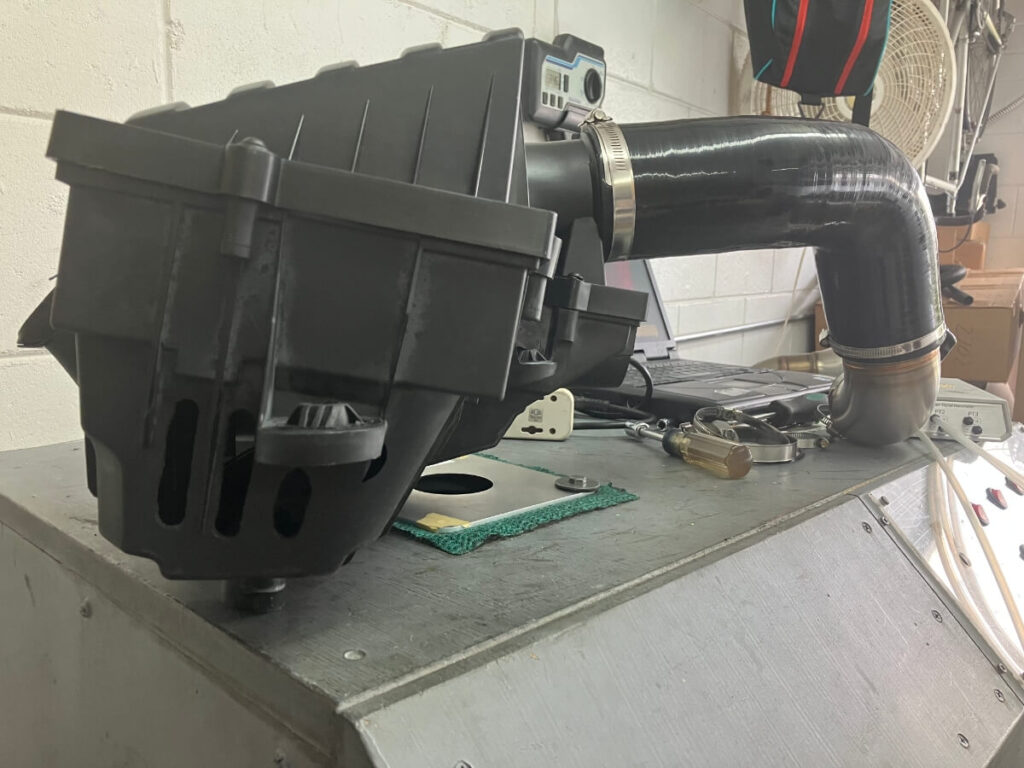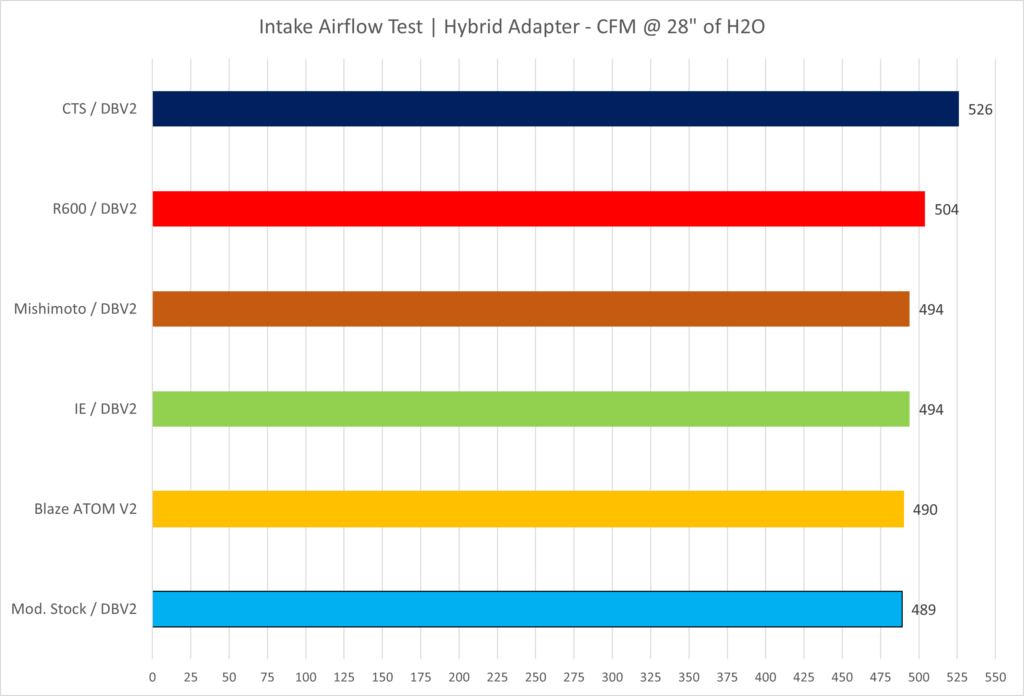Background:
Testing results with the Blaze Performance intake parts shifted my focus from stock-size turbocharger intake optimization to hybrid-size turbocharger intake optimization.
Before testing with the Blaze intake parts I didn’t have a target size for a hybrid-turbo compressor inlet, so I used a silicone hose to represent what I thought a hybrid-turbo inlet diameter might be.
Blaze communicated to me that 56 mm was a representative diameter for a hybrid-turbocharger inlet, and is what they developed their inlet flange to work with. That insight allowed me to develop a model for a hybrid turbo inlet to have a more representative adapter for making comparisons.

In a past post, I compared several intakes matched with the hybrid-optimized DBV2 turbo inlet elbow and the new hybrid-turbo adapter. Those results showed that the selection of a hybrid-optimized inlet elbow led to a significant increase in airflow through the intakes.
During that test I also measured a stock airbox with some common modifications; removal of the snow guard/baffle, an aftermarket air filter, and an aftermarket inlet hose.

Airflow through the modified stock intake was ~8-15% below what has been measured from aftermarket intakes using the hybrid turbo adapter, although the absence of the stock air duct helped to increase the airflow.
These results led me to consider how the stock intake might perform if the best flowing parts I have on hand were combined to make the ultimate stock intake for a hybrid turbo setup.
For this test, I would install the duct which will reduce airflow slightly, and use a stock airbox lower half with some slots cut into it (described in detail here), which will increase airflow slightly.
Would the net effect of these changes be sufficient to close the gap with the aftermarket intakes?
Test Procedure:
A stock Mk7 GTI intake is modified in the following ways:
- The snow guard / air baffle inside the airbox is removed.
- The stock air filter is replaced by a 034 Motorsports panel air filter. (Tested recently as described in this post)
- The stock air duct is opened at the front on the driver’s side and the rear on the passenger side is blocked off.
- The stock accordion hose is replaced with an MST Performance silicone hose.
- Three slots are cut into the lower half of the airbox.
- The stock GTI turbo inlet elbow is replaced by a hybrid-optimized DBV2 turbo inlet elbow.

With the modification to the airbox completed a calibration check of the flow bench is performed and the hybrid turbo adapter is attached to the flow bench.
Next, the air intake is assembled and connected to the flow bench adapter.

Airflow through the intake is measured at a depression of 28″ of H2O.
Test Results:
The modified stock GTI airbox flowed 489 CFM @ 28″ of H2O. This is shown on the chart below along with some aftermarket intakes that have been flow tested using the hybrid-turbo adapter.

Conclusions:
Several modifications were made to a stock GTI air intake based on prior test results that identified optimal parts to use in support of high airflow rates through a hybrid-turbo-sized adapter that simulates the compressor inlet of a hybrid turbocharger.
Previous tests with the modified stock airbox showed the stock system trailing aftermarket intakes anywhere from ~8-15% percent.
With the changes described above the airflow through the stock intake improved significantly, such that the stock system now trails the aftermarket intakes by ~0.2-8% depending upon which aftermarket intake is being compared.

Oh wow. The modded stock intake was flowing identical to the blaze 😂
Has eqt published their alleged third party findings yet? I haven’t been around lately
Yes. It makes me want to go back and try testing this set of stock box modifications with the IHI sized adapter to see how it compares with the aftermarket intakes.
I haven’t seen anything from EQT. I doubt they ever will provide comprehensive information since the intake doesn’t perform any better than the other aftermarket intakes, it’s the turbo inlet flange that is producing the gains versus stock size inlet elbows.
Oh man that would be interesting. What mods to the stock intake would truly create a Frankenstein!
I don’t think it would be too different from what I’ve tested in the past. Just with an extra 10 CFM or so from the stock airbox that would put it in the grouping with the top flowing aftermarket airboxes, through the IHI adapter.
Would the cutting of the slots in the lower area lead to an increase in WGDC?
I revert to my Frankenstein stock airbox in the summer as my open Apr setup is 10-15 degrees higher than when I stock in my daily driving. I have the stock IS20 on Apr stage 2.
If it can flow as good as the “best” aftermarket options, I might just leave it in and sell the Apr.
I think the positive or negative effects of cutting the stock airbox are going to be small. It allows a little higher airflow, but it’s also allowing the intake to draw the extra air from the engine compartment, which raised the air temperature a few degrees.
Hi Jeff,
Have you tried putting a R600 air filter into a VW airbox? I’d be interested to see how much of a difference the box makes compared to the filter.
Big thanks for the effort you’ve put into the site.
Thanks Andrew! I have not tried that, I think it would require some extensive modifications to the stock airbox since the R600 filter has a plastic plate on the back.